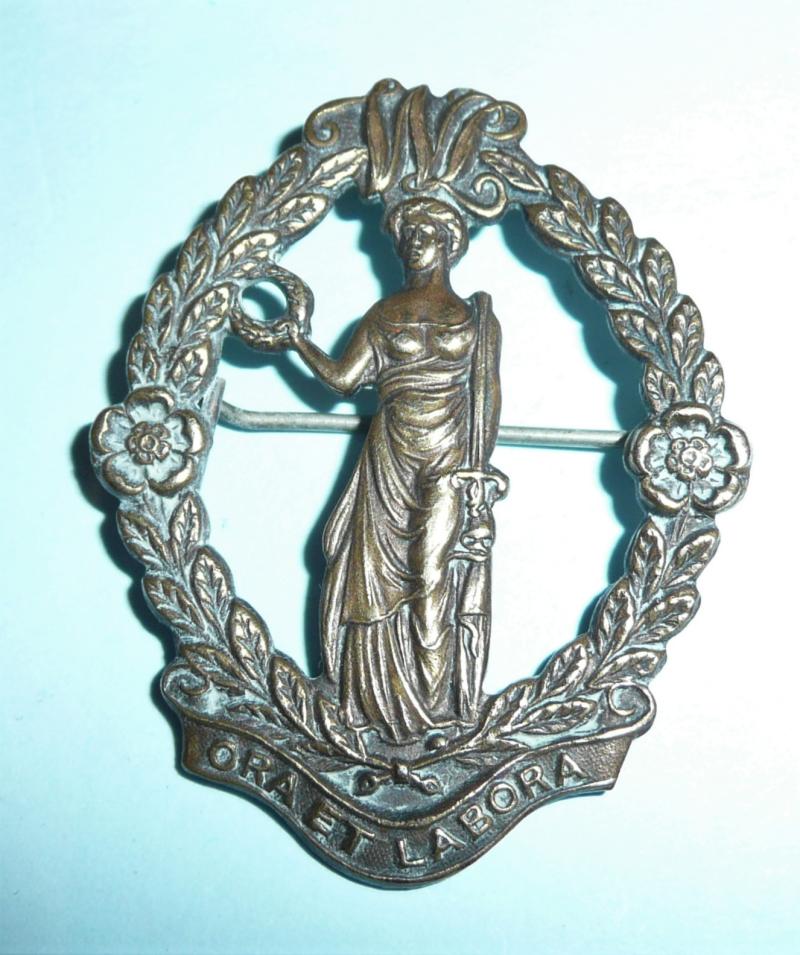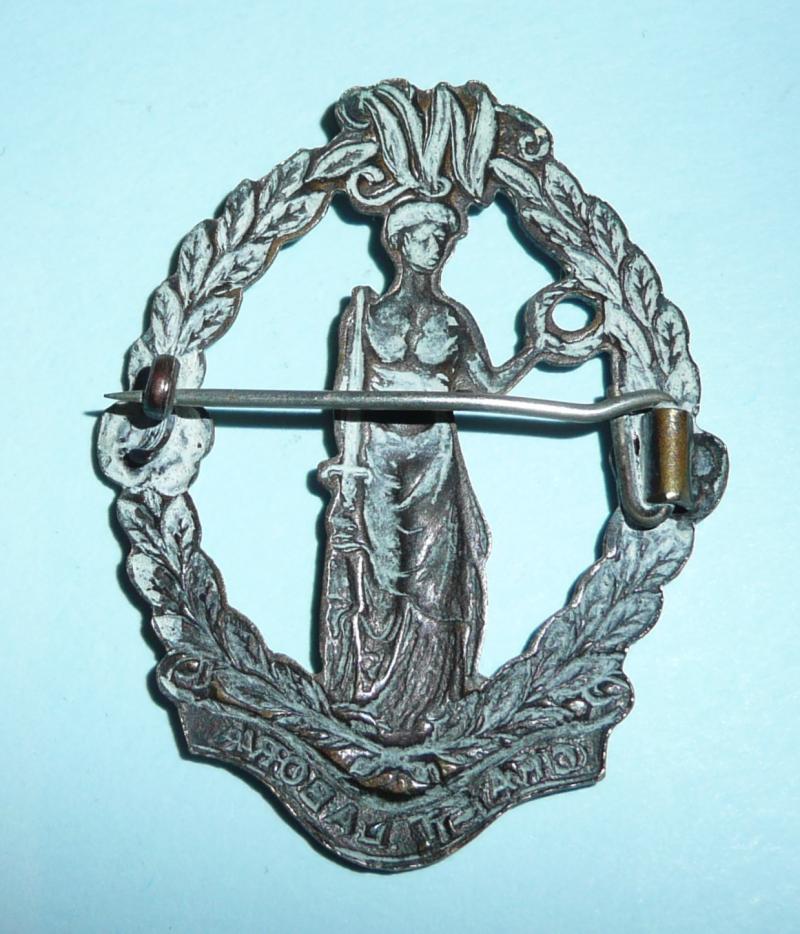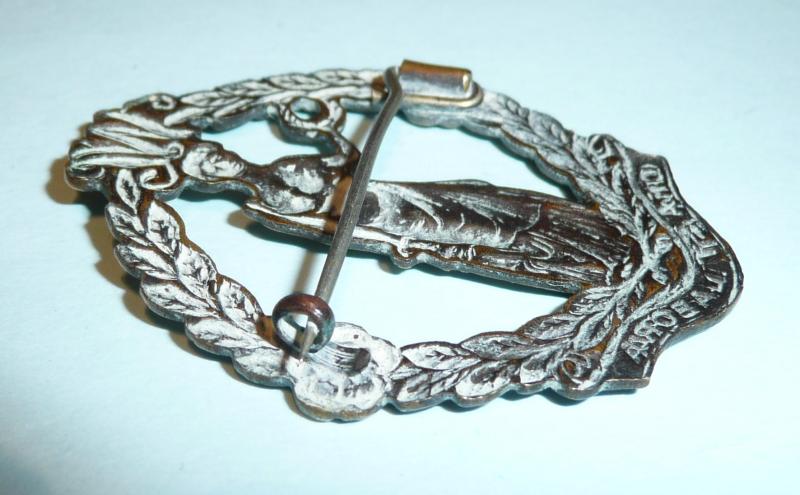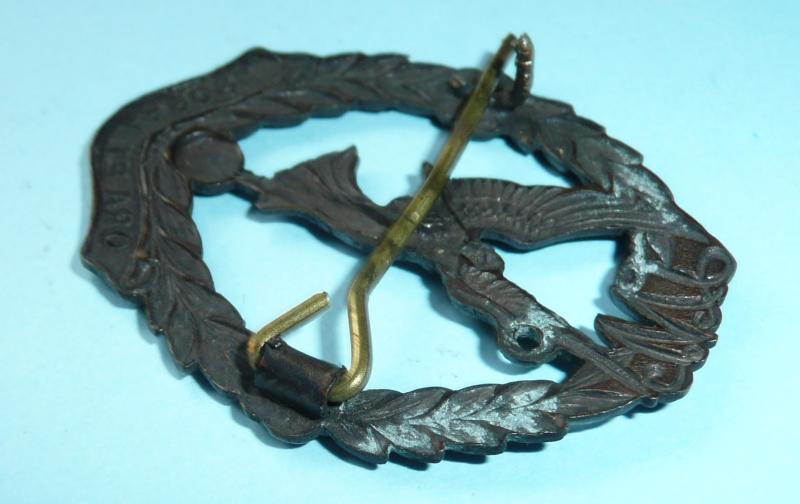WW1 Home Front - Womens Legion (WL) Brooch Pin Badge
Die struck in bronze. Earlier pattern with wings on the figure of victory. Sadly C clasp is damaged and tip of pin has been truncated slightly otherwise in good condition. Circa 4.5cms tall. Condition reflected in price. No returns on this item. Sold as seen.
(A claret / maroon cloth backing would indicate a motor transport driver. However, no cloth backing present).
The formation of the Women’s Legion (WL) took place at a meeting held at Londonderry House in July of 1915 “to provide a capable body of women whose services can be offered to the state as may be required, to take the place of men needed in the firing line or in other capacities”. Its founder, Lady Londonderry, had for some time been discontented with what she considered to be an excess of militarism which had been displayed by some of the women’s organisations which had been formed on the outbreak of war, particularly the Women’s Volunteer Reserve (WVR), of which she was Colonel -in-Chief. She believed that “it was absolutely necessary to re-organise the composition of the WVR. If the movement was really to grow and extend, it must be on less military lines”.
As first envisaged, the WL was to be an umbrella organisation and to comprise a number of different sections, of which the WVR was to be the first, plus Canteen, Ambulance and Cookery. After a few months, however, the WVR reverted to its original régime and severed connections. Other sections were formed before the end of the war, including Agricultural and Motor Transport. By far the most important, however, were the two sections which provided womanpower for the British Army, Military Cookery and Motor Transport.
The Military Cookery section has the distinction of being the first body of women, apart from nurses, to be employed with the British Army. It was formed on 22 July 1915, and, in the same month, a party of 20 cooks was despatched to Dartford Camp Convalescent Hospital. Parties for Eastbourne and Epsom camps soon followed and by the beginning of 1916, there were 120 cooks in place. The whole organisation was run from headquarters in the Duke of York’s at Chelsea by the Secretary, Mrs. Long. Lists of volunteers were kept and cooks and waitresses despatched as demanded by various units who engaged them through Labour Exchanges as civilian employees. The first Commandant was Miss Lilian Barker, who later went on to be Lady Superintendent of the munitions workers at Woolwich Arsenal. She was followed by Mrs. Burleigh Leach who later became head of the Women’s Army Auxiliary Corps (WAAC).
The service expanded, not only to convalescent camps but to command depots and other units, their conditions of service being officially laid down in Army Council Instruction (ACI) 2034 of 1916. In January 1917 the Army Council appealed for 1000 women to enroll in the WL as cooks and waitresses. Some 26,000 replies were received. This success was such that the War Office decided to extend the service to France and to take complete control of the workforce. Thus, the Military Cookery Section of the WL ceased to exist on September 1917 when all 6,000 cooks and waitresses in the United Kingdom were absorbed into the newly formed WAAC. They eventually adopted WAAC uniform but were permitted wear their old WL badge on their lapel.
The Military Motor Transport section grew out of a plan formed in January 1916 to organise an Ambulance Corps to work with the Red Cross in France. This did not materialise and instead it was found more practical to develop a home service and the WL was approached to help. Miss Christabel Ellis was appointed Commandant and began the collection of experienced women drivers to work for the Army Service Corps(ASC). The first 20 women were supplied in April 1916 and on 30 October 1916 members of the section were given the privilege of wearing ASC badges and buttons on their uniforms. Drivers working with the Royal Flying Corps later wore that badge on their hat and shoulder titles. The women normally worked under a Superintendent in squads of up to 22, of which at least 10 were mechanics/drivers. The was also a Head Driver, Probationers and Garage Washers. Their conditions of service were laid down in ACI 221 of 1917.
On 16 March 1918, The Queen inspected a parade of 225 drivers who were representing the 2000 then employed from Cornwall to Scotland. On the formation of the Women’s Royal Air Force on 1 April 1918, some 647 drivers who had been working with the Royal Flying Corps transferred into the new service. However, as the Quartermaster General felt that his army drivers should be controlled only by the ASC, those working at home never transferred to the WAAC.
None of the sections of the WL served overseas during the war, though members of the Motor Transport section did so in some numbers after the Armistice. Many members of the Cookery section served in France, but as members of the WAAC.
Comm DaSm
Code: 65838
35.00 GBP




